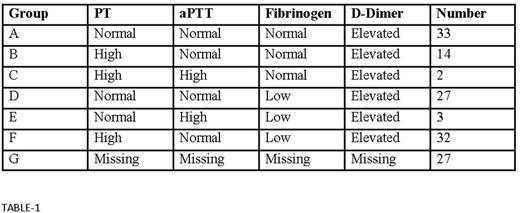Abstract
Introduction:
Acute Promyelocytic Leukemia (APL) is a rare but highly curable malignancy. A large majority of these patients present with (DIC) resulting in bruising, bleeding and in some patients life threatening hemorrhage. Hematologists caring for APL patients frequently note the prothrombin time (PT), activated partial thromboplastin time (aPTT) and fibrinogen levels and, if normal, presume the patient does not have DIC. Our observations suggest that a normal PT, aPTT, or fibrinogen level do not eliminate DIC and bleeding risk in APL patients and that an elevated d-dimer is the most sensitive, but often under-utilized, indicator of DIC.
Methods:
Retrospective chart review was conducted with IRB approval on patients diagnosed with APL and treated at Emory University Hospital and those co-managed at treatment centers in Georgia, South Carolina and neighboring states as part of our initiative to decrease induction deaths. Patients managed from 7/2013 through 4/2017 were included in the analysis. The PT, aPTT, Fibrinogen, d-dimer levels and signs of bleeding on the day of diagnosis were collected. A normal PT level was anything below 15.5, a normal aPTT level was anything below 36.5, and a normal fibrinogen level was above 200. Elevations in d-dimer were based on laboratory specific reference values.
Results:
One hundred and thirty-eight patients were enrolled in this study. Of the 138 patients, 115 had d-dimer levels drawn on the day of admission to the hospital (day 1). Of those 115 day 1 d-dimer levels, all 100% of them were elevated. Seventy-three of the 138 patients (52.90%) presented with signs of bleeding including but not limited to: bruising, epistaxis, abnormal menstrual bleeding, hematuria, hemoptysis, hematochezia and melena. Sixty-three patients (56.76%) presented with a normal PT and high d-dimer levels, while only 48 (43.24%) presented with a high PT and high d-dimer. Of the 63 patients presenting with normal PT/INR levels, 54% of them had bleeding symptoms on day 1. Forty-nine of 115 patients (42.6%) had normal fibrinogen levels on day 1. Notably, only six of the 138 patients included in this study presented with elevated aPTT levels. Twenty-seven patients did not have complete coagulation panels drawn on the day of admission, thus they were omitted from the above analysis. However of these patients missing either PT, aPTT, fibrinogen or d-dimer levels on day 1, 37% presented with signs of bleeding. These data are depicted in Table 1.
Conclusion:
All patients with APL on whom day 1 data was available had elevated d-dimer levels, even in the setting of a normal PT, aPTT and fibrinogen. An elevated d-dimer level was found to be the more sensitive indicator for coagulopathy in patients with APL. Further, over half of patients with normal PT levels presented with signs and symptoms of bleeding and only six patients presented with abnormal aPTT levels. The most important observation from this study is that a normal PT, aPTT, or fibrinogen level - combined or in isolation - does not eliminate the risk of DIC or life threatening bleeding. Hematologists caring for patients with suspected or newly diagnosed APL must check a complete coagulation panel, including d-dimer, on day 1 and regularly thereafter. We theorize this will result in early recognition of DIC leading to prompt and aggressive management of coagulopathy and decrease early hemorrhagic deaths in this very curable malignancy.
Arellano: Cephalon Oncology: Research Funding. Kota: Xcenda: Consultancy; Pfizer: Consultancy; Novartis: Consultancy; Incyte: Consultancy; Leukemia Lymphoma Society: Research Funding; Takeda Pharmaceuticals: Consultancy.
Author notes
Asterisk with author names denotes non-ASH members.


This feature is available to Subscribers Only
Sign In or Create an Account Close Modal